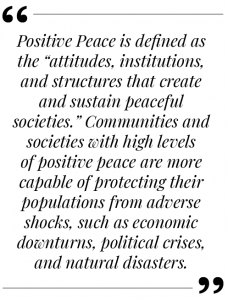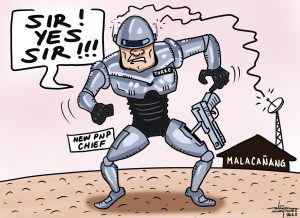 LAST NOVEMBER 7 and 8, I had the privilege of facilitating the first-ever Peace WEmboree in the country held at Garden Oases Convention Center, Davao City.
LAST NOVEMBER 7 and 8, I had the privilege of facilitating the first-ever Peace WEmboree in the country held at Garden Oases Convention Center, Davao City.
It is actually an updated version of WEmboree, a component of “Operation Listo” of the Department of Interior and Local Government (DILG) that engages the youth in community preparedness and disaster response. We’re calling it WEmboree 2.0 because Peace WEmboree offers a deeper understanding of how resilience and peace are related concepts and how young people can participate meaningfully in building resilient and peaceful communities.
In early 2023, DILG, under the leadership of Secretary Benhur C. Abalos, Jr., adopted the Positive Peace Framework proposed by Local Government Academy (LGA) Trustee Irene M. Santiago, who is an internationally recognized leader involved in the promotion of gender equality and positive peace.
Positive Peace is defined as the “attitudes, institutions, and structures that create and sustain peaceful societies.” Communities and societies with high levels of positive peace are more capable of protecting their populations from adverse shocks, such as economic downturns, political crises, and natural disasters. These communities also tend to rebuild their internal structures and recover more rapidly in the aftermath of such shocks.
This framework that measures a community’s resiliency and well-being is developed by the Institute for Economics and Peace (IEP), an independent, non-partisan, non-profit think tank based in Australia. IEP partnered with Kahayag Foundation, a non-government organization based in Davao City, to promote and integrate Positive Peace in local communities in the Philippines.
The first Peace WEmboree is a collaboration of LGA, DILG Region 11, and the Kahayag Foundation. The pioneering batch of 40 young leaders came from different parts of Mindanao — Regions 10, 11, 12, and the Bangsamoro Autonomous Region in Muslim Mindanao (BARMM).
I am happy and proud to report that our collaboration created new connections not just among the organizers, but also among the mentors and the participants. It also created new connections in our individual and collective brains — so many “Aha!” moments and new neural pathways blazed.
We started our two-day journey creating “houses” a la “Game of Thrones” where the diverse group of participants discover their shared values that would then represent their houses. Then all the houses are threatened by an alien invader and ordered to unite or else the world ends. It’s a wonderful way for young people to immediately bond and get to know one another through the values they hold dear.
Mentor Mia Corpus of the CoRE Group led the session on “The Foundation Within: Uncovering our Circles of Humanity to Build Connections.” The session made us realize how it is easy for people to be programmed and reprogrammed like our computer devices that come with a built-in operating system and how we can be programmed a certain way based on the apps we download throughout our lives. The good news is at our core are our human values. Knowing what those values are will enable us to connect with others who also share them. Our values bring us to the “Zone of Understanding.”
In “Exploring Our Interconnected Identity: Unveiling Cultural and Natural Values in Our Shared Spaces,” mentor Gloryrose Dy-Metilla, an architect, offered a new way of seeing the world around us. She compared buildings to our bodies and shared that buildings, like people, have personalities and age over time. They communicate their function, history, and how to interact with them. Like our bodies, buildings can be healthy or unhealthy. So our relationship with our surroundings also influences how we behave. The session made us appreciate how our body is part of a village and of a map and how we are all connected in time and space.
Mentor Jon Traya, founder of the TAYO Movement, led the exploration of “Asset Framing: How our Strengths and Interests Can Catalyze Change.” Asset Framing is a narrative model that defines people by their assets and aspirations before noting their challenges and deficits. More often, in the context of disaster or conflict, the youth are categorized only either as the perpetrator or the victim. What about their capacity to create positive change? Young people can build peace by starting with what they are passionate about.
Coach Noli Ayo, co-founder of the Mindanao Peace Games, shared how sports teach young people in “Creating Networks That Work.” What resonated most with the young leaders is the importance of choosing the right people to journey with. Coach Noli also introduced how to positively frame our relationship with others as “kalaro, kaibigan, kasama.” He said that when we play a sport or a game, we do not call the other team “kalaban” (opponent) but “kalaro” (playmate) who would later become a “kaibigan” (friend) and then become a “kasama” (partner) in working towards a shared goal.
Mentor Dexter “Rob” Tañedo, founder of La Herencia, introduced Renga Art as a way for young people to collaborate creatively and integrate diverse points of view into one coherent work of art. Inspired by Japanese renga, which means “linked poem,” it is a collaborative composition of a poem where poets work in pairs of small groups taking turns composing alternative three-line or two-line stanzas. Instead of words, the participants drew images to create one painting to showcase as a group. Their artworks were amazing displays of creativity and the workshop exercised their ability to draw deeper meanings from the images they created.
It all leveled up with the next session on “Weaving Identities and Connections through Soulmaking” by mentor Norman “Noi” Narciso. It was an interactive session on how art, action, and activism can be used to create positive change and build peaceful communities. He introduced to us the creative process of “soulmaking” — developing the artist in all of us; exploring our imagination and finding meaning in what we do and the stories we tell in our everyday life; connecting with other people and with nature, with time and space; and building peace through those connections.
Our closing ritual was also led by Noi and he called it “Ugong sa Pakighinabi” (resonance of dialogue or hum of conversation) where we all created music using various improvised and recycled instruments (including our own voices and bodies). Participants took turns being the conductor of our orchestra and each symphony we made was unique. Each one was fully present, listening to one another, aware of every move, swaying to the collective beat, paying attention to our conductor, and relishing being in the moment and delighting in creating something new together. What a glorious way to end our Peace WEmboree on a high note!
Our super mentor, Irene “Inday” Santiago, who set the tone for our entire journey, started by inspiring us with the poem by Joseph Campbell, “Follow Your Bliss.” She said that when we follow our bliss, we live a meaningful life doing what we love to do. It is living a creative life in the service of others.
She shared that in times of peace, there are two things in abundance — hope and trust. “With hope, we can dream. With hope, we can act. With trust, we can dream together. With trust, we can act together. So in a world that is faced with crises on many fronts, we have to hold on to both.”
Peace WEmboree changed and enriched our lives. It did not just change our mindset from “ME” to “WE” but it also shifted our frame from the “devastating OR” (me or you) to the “awesome AND” (me and you).

